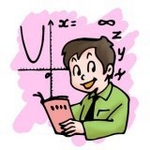
Worksheets and No Prep Teaching Resources
Reading Comprehension Worksheets
History of Mathematics

History of Mathematics
 Worksheets and No Prep Teaching Resources Reading Comprehension Worksheets History of Mathematics |
 History of Mathematics |
| edHelper's suggested reading level: | grades 9 to 12 | |
| Flesch-Kincaid grade level: | 10.23 |
|
Money and Measurement - Babylonian Mathematics
By Colleen Messina |

|
 1 Mesopotamia, which means "The Land between the Two Rivers," was located one thousand miles east of the delta of the Nile River in between the Tigris and Euphrates Rivers. The Babylonian civilization flourished at about the same time as the Egyptian civilization. The Babylonians lived in a large desert, and they had a legal system, a postal system, and irrigation systems. The environmental differences between Mesopotamia and Egypt led the Babylonians to develop different areas in mathematics.
1 Mesopotamia, which means "The Land between the Two Rivers," was located one thousand miles east of the delta of the Nile River in between the Tigris and Euphrates Rivers. The Babylonian civilization flourished at about the same time as the Egyptian civilization. The Babylonians lived in a large desert, and they had a legal system, a postal system, and irrigation systems. The environmental differences between Mesopotamia and Egypt led the Babylonians to develop different areas in mathematics. |
Create Weekly Reading Books
Prepare for an entire week at once! |
| Leave your feedback on Money and Measurement - Babylonian Mathematics (use this link if you found an error in the story) |
 |
History of Mathematics
|
 |
High School Reading Comprehensions and High School Reading Lessons
|
 |
Social Studies
|